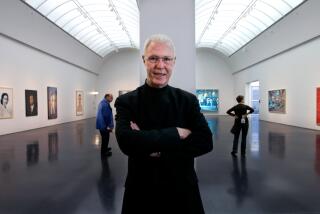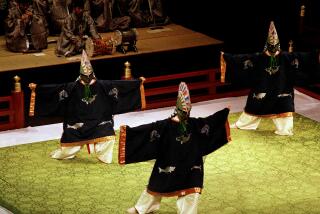Irvine Lacks ‘Artistic Soul,’ Symposium Speakers Say
The city of Irvine may have achieved recognition as a model of residential and commercial planning, but it has lagged in developing an “artistic soul,” government and arts leaders told a cultural symposium Friday.
“Something is still largely missing in this community, despite all the orderly planning and manicured lawns. We have the sense that our artistic impulses have not been fully translated into public policies,” Irvine Mayor Larry Agran told the city-sponsored gathering of 150 at the headquarters of Trammell Crow Co.
The call for expanding cultural programs raised another key issue at the “Arts Irvine: 1990” forum: how to find more funds for the arts at a time of ever-tougher competition from an increasing number of arts causes.
‘We Have to Work Harder’
“It means we have to work harder. We have to be more innovative in developing even stronger arts partnerships with private and public sources,” said Councilwoman Sally Anne Miller, a longtime arts activist.
However, symposium speakers avoided making any concrete proposals for finding new funds, such as special taxes or expanding public-art requirements for private developments.
“Our task today is to just air ideas, to consider the whole range of possibilities,” said Donald Rickner, an Irvine Valley College administrator and chairman of the Irvine Arts Alliance, the city advisory body that co-sponsored Friday’s symposium.
Rickner said an alliance task force will consider program and financing “specifics” after community hearings this summer. Alliance recommendations will then be submitted, possibly this fall, to the city Community Services Commission and City Council.
Even so, Irvine was praised for getting a faster start on cultural planning than most cities by the other symposium speakers: former state Sen. Alan Sieroty, San Francisco Arts Commissioner Ray Taliaferro, Los Angeles Music Center fund leader Lee Howard and former Long Beach Arts Administrator Judith Luther.
Bond-Financed Theater
In addition to a wide-ranging performing and recreation arts program, the city has established a major Fine Arts Center gallery and educational complex, city representatives said. And the construction of a $9.5-million Irvine City Theatre on the UC Irvine campus is being financed with city-issued bonds. Construction is set to start this fall on the 750-seat theater, which is to house both community and university performances and cultural lectures.
Also, the city has started a public-art effort with local developers, including a program that encourages developer donations of outdoor sculptures and other art. The first in this program is a $53,500 Koll Co.-financed sculpture that will be in front of the new county library at Heritage Park.
Among the revenue-raising ideas brought up by symposium speakers was to use special tax funds, such as allocations for arts from tourist-related taxes, or to adopt more stringent public-art requirements. Some cities, such as Brea and Laguna Beach, have adopted programs that require large developers either to donate public-art works or be levied art-fund fees.
Endowment Drive Delayed
The problem of finding fiscal support is apparent in the Irvine City Theatre project. Theater board officials have estimated that operating costs may be at least $700,000 a year. But the only corporate donation to date for theater operations has been $100,000 from the Irvine Co. And the theater board has delayed a drive to raise $10 million for an endowment that would be used mostly for underwriting annual operations.
The symposium’s panel discussion ended with a call for ensuring that artistic diversity be preserved in any community program. “These (arts) programs are meant to stimulate thought,” Sieroty, a Los Angeles city arts commissioner, said. “They should be open to all ideas, even those that some find offensive. They should welcome controversy.”
Added Taliaferro, the symposium’s keynote speaker: “We talk about cultural exchanges between nations. In this case, we’re talking about cultural exchanges among the various and different cultures in our own community. Arts can be a unifying force.”
More to Read
The biggest entertainment stories
Get our big stories about Hollywood, film, television, music, arts, culture and more right in your inbox as soon as they publish.
You may occasionally receive promotional content from the Los Angeles Times.










